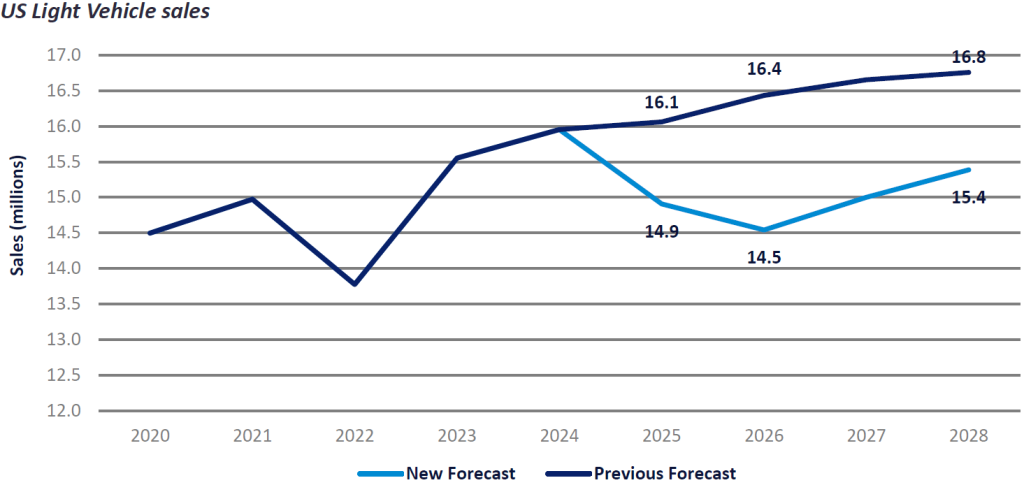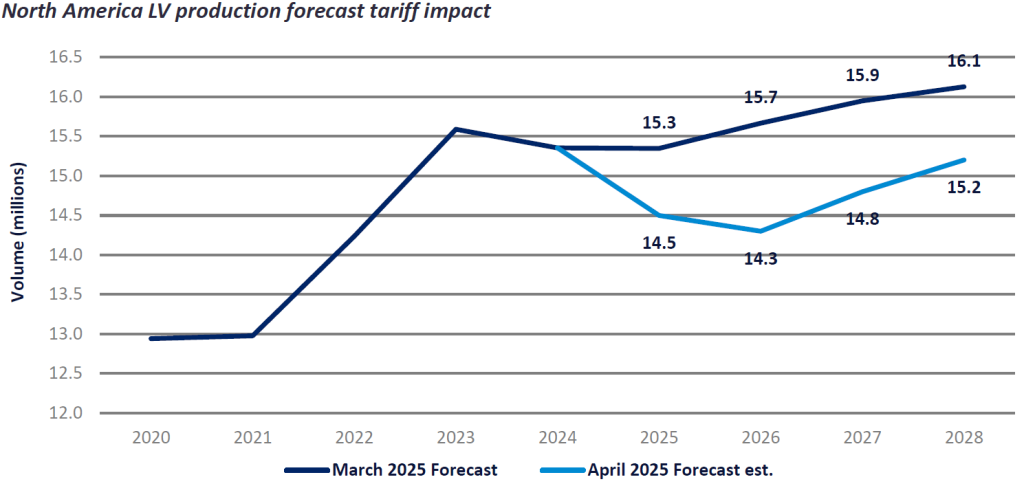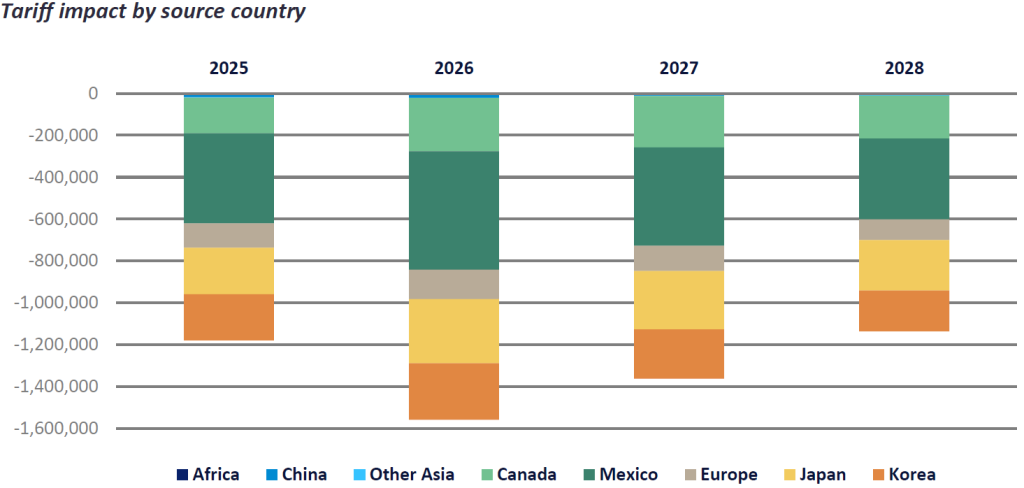GlobalData has carried out detailed analysis on the likely impact of tariffs on automotive imports to the US, including both finished Light Vehicles (LVs) and automotive parts.
The following represents a summary of the tariffs that relate to the automotive industry:
- As of April 3rd, 25% tariffs are in effect on imports of finished vehicles. While this applies to all countries, vehicles from Canada and Mexico that are compliant with the USMCA trade agreement rules are subject to taxes only on their non-US content. US content is defined as “the value of parts “wholly obtained, produced entirely, or substantially transformed in the United States.”
- For vehicles not compliant with the USMCA and imported from Canada or Mexico, additional 25% tariffs stack on top of existing tariffs, raising the total to 50% in some cases.
- 25% tariffs on a number of automotive parts – including engines, transmissions, powertrain and electrical components – will go into effect on May 3rd. Parts that are compliant with the USMCA rules will not be taxed until the US Commerce Department establishes a process to apply the tariff to only non-US content.
- 25% tariffs on steel and aluminum imports are also in effect. Derivative products of these metals are also subject to tariffs, which would include some automotive parts such as bumpers. There are no exemptions for certain trading partners, as had previously been the case.
- The reciprocal tariffs announced on April 2nd do not apply to the automotive industry.
The impact of these tariffs will be far-reaching, given that around 47% of LVs sold in the US in 2024 were assembled outside the country, and those that were built in the US generally contain significant percentages of imported content.
Navigate the shifting tariff landscape with real-time data and market-leading analysis. Request a free demo for GlobalData’s Strategic Intelligence here.
While some of the additional costs may be absorbed by OEMs and the supply chain, we expect the majority of the cost increases to be passed on to the consumer. This will exacerbate existing problems with affordability in the US market and therefore decrease sales.
Our Q1 2025 forecast called for 16.1 mn US sales in 2025, and 16.4 mn units in 2026. However, that forecast was produced before the latest announcements and assumed that the threat of tariffs was largely a negotiating tactic that was being used to extract concessions from other countries. While we did factor in a slight negative impact on sales due to the uncertainty being created by the constantly changing trade picture, we did not assume that any tariffs would actually go into effect. We now estimate 2025 US sales at 14.9 mn units. This represents a decrease of 6.6% YoY and a reduction of 1.2 mn from our Q1 2025 forecast. For 2026, we expect sales to decline further, to 14.5 mn units, with the tariffs assumed to be in effect for the full year. We assume that the tariffs remain in place permanently, as it could be difficult for future administrations to remove them due to Union opposition. Over time, greater localization of production and adjustments in consumer expectations around pricing could see sales gradually recover, while remaining below the pre-tariff outlook.

US Tariffs are shifting - will you react or anticipate?
Don’t let policy changes catch you off guard. Stay proactive with real-time data and expert analysis.
By GlobalDataOur new forecast incorporates all the tariff measures outlined above, although some of the details of how exactly these tariffs will be applied in reality, and which models will fall foul of USMCA non-compliance, are not yet entirely clear. There are both upside and downside risks to the forecast, depending on how the tariffs are applied and how OEMs and consumers react, as well as developments in the wider economy. As such, there is a much higher degree of uncertainty in our forecast than would usually be the case.

Production Impact
In 2024 automakers built 15.4 mn LVs in North America and the production footprint consisted of 66% US-built models, while Mexico production accounted for 25% and Canada 9%. However, aided by new investment in Mexico, their share was expected to rise to over 26% in 2025.
Under the current tariff implementation, significant risk would be added to our North American LV production forecast and the manufacturing footprint outlaid in it. The tariffs could potentially cut nearly 850k units (-5.5%) out of the 2025 forecast and plunge the full-year result to 14.5 mn units – the lowest total since 2021 during the semiconductor crisis. If the tariffs are maintained through 2028, they could take out over 4.0 mn units from our base forecast over the period.
While we are already seeing several production stoppages in Canada and Mexico due to the tariffs, notably at Stellantis’ Windsor and Toluca vehicle assembly plants as well as at Nissan’s COMPAS JV plant in Aguascalientes, more are certain to follow as automakers manage their impacted inventory and as production is hampered due to tariff-related parts disruption and ultimately plant shutdowns.

While North American production (US/Canada/Mexico) dominates the supply of vehicles to the US market, almost a quarter of US LV sales are sourced from elsewhere.
Japan and Korean-built vehicles, combined, account for around 17% of US LV Sales, while European-assembled models have over a 5% share. This level of exposure to the downgraded US market will thus impact production volume in these regions.
While European LV output could be negatively affected by an annual average of 120k, Japanese and Korean volumes could slip by 260k and 230k, respectively.
Much depends on the entrenched nature of these new tariffs as well as the scale of potential retaliation. Risks are elevated: a global trade war is probably now already underway and the dynamic impact upon supply chains, geographical sourcing patterns and, indeed, world economic growth is set to emerge.

This article was first published on GlobalData’s dedicated research platform, the Automotive Intelligence Center.




